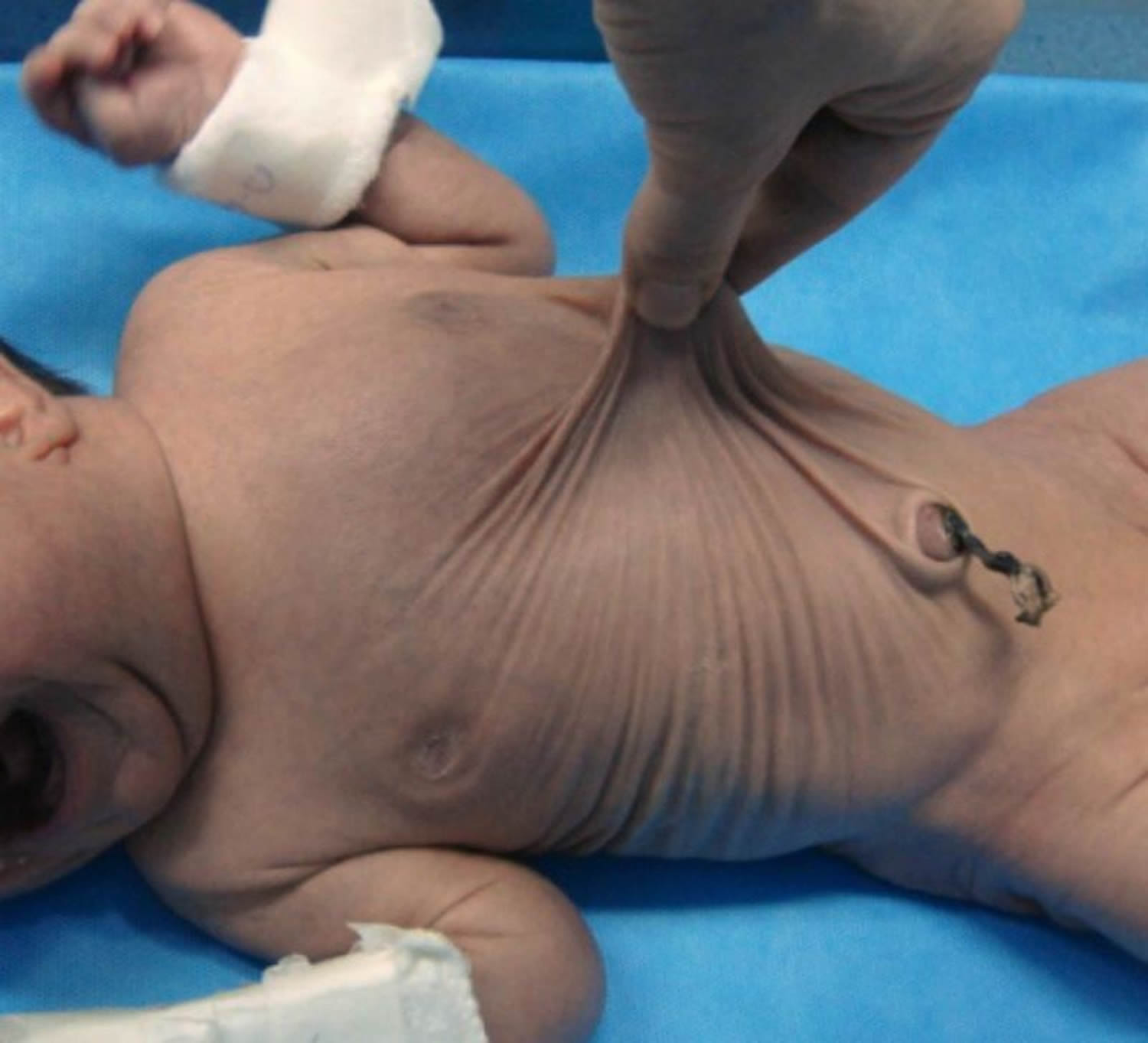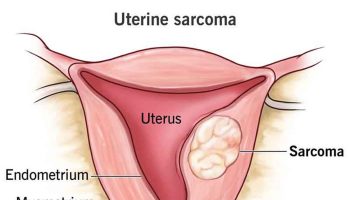What is cutis laxa
Cutis laxa (Latin for loose or lax skin) also known as generalized elastolysis, is a rare, inherited or acquired disorder of connective tissue that causes the skin to stretch easily and hang in loose folds and in some cases cutis laxa is associated with internal organ involvement. Cutis laxa can affect connective tissue in other parts of your body, including your heart, blood vessels, joints, intestines, and lungs. Cutis laxa is characterized by loosely hanging skin that lacks any elasticity. The way in which cutis laxa presents itself is different according to how it is inherited or acquired. Depending on which organs and tissues are affected, the signs and symptoms of cutis laxa can range from mild to life-threatening 1. Cutis laxa can cause heart problems and abnormal narrowing, bulging, or tearing of critical arteries. Severe impairments of the heart, lungs, arteries, or intestines can be fatal. Affected individuals may have soft out-pouchings in the lower abdomen (inguinal hernia) or around the belly button (umbilical hernia). Pouches called diverticula can also develop in the walls of certain organs, such as the bladder and intestines. During childhood, some people with cutis laxa develop a lung disease called emphysema, which can make it difficult to breathe.
Cutis laxa is a rare disorder. About 200 affected families worldwide have been reported.
Connective tissue is the body’s supporting framework of tissue consisting of strands of collagen, elastic fibers between muscles and around muscle groups and blood vessels, and simple cells. In cutis laxa, the elastic fibers (fibers that enable tissue to stretch and then spring back into place) contained in the connective tissue (the tough, often fibrous tissue that binds the body’s structures together and provides support and elasticity) become loose. Sometimes only the skin is affected, but connective tissues throughout the body can be affected.
Cutis laxa may be acquired or inherited. However, cutis laxa is usually hereditary. The different forms of inherited cutis laxa are distinguished by their pattern of inheritance: autosomal dominant, autosomal recessive or X-linked 2. In general, the autosomal recessive forms tend to be more severe than the autosomal dominant form. The X-linked recessive variant of cutis laxa is rare, with skin laxity and skeletal and genitourinary tract abnormalities. X-linked cutis laxa (elastolysis) is identical to Ehlers-Danlos syndrome type IX, and both conditions are now known as occipital horn syndrome 3. The X-linked form of cutis laxa is also considered a mild type of Menkes syndrome, which is a condition that affects copper levels in the body. In addition to sagging and inelastic skin, occipital horn syndrome is characterized by wedge-shaped calcium deposits in a bone at the base of the skull (the occipital bone), coarse hair, and loose joints. In general, the autosomal recessive forms of cutis laxa tend to be more severe than the autosomal dominant forms. In addition to the features described above, some people with autosomal recessive cutis laxa have delayed development, intellectual disability, seizures, and problems with movement that can worsen over time.
In some kinds of cutis laxa, the abnormal genes cause problems unrelated to connective tissues. For example, the genes may cause disorders of the heart, lungs, or digestive tract or intellectual disability. Rarely, infants can develop cutis laxa after an illness that causes fever or after having an allergic reaction to penicillin. In children or adolescents, cutis laxa usually develops after a severe illness involving fever, inflammation of organs such as the lining of the lungs or heart, or erythema multiforme (patches of red, raised skin). In adults, it may develop with other disorders, particularly plasma cell disorders.
What causes cutis laxa?
The actual underlying cause of cutis laxa is unknown. Several mechanisms appear to be involved in reducing elastic fibers. However, most cases of cutis laxa are inherited. There are several forms of genetic inheritance: sex-linked, autosomal dominant, and autosomal recessive. The recessively inherited form of cutis laxa is the most common and also the most severe. Recently discovered, cutis laxa can be caused by mutations in several genes, including ATP6V0A2, ATP7A, EFEMP2, ELN, and FBLN5. Most of these genes are involved in the formation and function of elastic fibers, which are slender bundles of proteins that provide strength and flexibility to connective tissue throughout the body. Elastic fibers allow the skin to stretch, the lungs to expand and contract, and arteries to handle blood flowing through them at high pressure.
The major component of elastic fibers, a protein called elastin, is produced from the ELN gene. Other proteins that appear to have critical roles in the assembly of elastic fibers are produced from the EFEMP2, FBLN5, and ATP6V0A2 genes. Mutations in any of these genes disrupt the formation, assembly, or function of elastic fibers. A shortage of these fibers weakens connective tissue in the skin, arteries, lungs, and other organs. These defects in connective tissue underlie the major features of cutis laxa.
Occipital horn syndrome (X-linked cutis laxa) is caused by mutations in the ATP7A gene. This gene provides instructions for making a protein that is important for regulating copper levels in the body. Mutations in the ATP7A gene result in poor distribution of copper to the body’s cells. A reduced supply of copper can decrease the activity of numerous copper-containing enzymes that are necessary for the structure and function of bone, skin, hair, blood vessels, and the nervous system. The signs and symptoms of occipital horn syndrome are caused by the reduced activity of these copper-containing enzymes.
Mutations in the genes described above account for only a small percentage of all cases of cutis laxa. Mutations in other genes, some of which have not been identified, can also cause cutis laxa.
Rare cases of cutis laxa are acquired, which means they do not appear to be caused by inherited gene mutations. Acquired cutis laxa appears later in life and is related to the destruction of normal elastic fibers. The causes of acquired cutis laxa are unclear, although it may occur as a side effect of treatment with medications that remove copper from the body (copper chelating drugs).
Inherited cutis laxa
- Sex-linked (X-linked) cutis laxa: The defective gene is carried on one of the sex chromosomes, in this case it is located on the X chromosome. Occipital horn syndrome has an X-linked recessive pattern of inheritance. It results from mutations in the ATP7A gene, which is located on the X chromosome. The X chromosome is one of the two sex chromosomes. In males (who have only one X chromosome), one altered copy of the gene in each cell is sufficient to cause the condition. In females (who have two X chromosomes), a mutation would have to occur in both copies of the gene to cause the disorder. Because it is unlikely that females will have two altered copies of this gene, males are affected by X-linked recessive disorders much more frequently than females. A characteristic of X-linked inheritance is that fathers cannot pass X-linked traits to their sons.
- Autosomal dominant cutis laxa: Autosomal dominant inheritance means one copy of the altered gene in each cell is sufficient to cause the disorder. A child has a 50% chance of inheriting the gene from either parent. When cutis laxa is caused by ELN mutations, it has an autosomal dominant inheritance pattern. Rarely, cases of cutis laxa resulting from FBLN5 mutations can also have an autosomal dominant pattern of inheritance.
- Autosomal dominant cutis laxa
- Autosomal dominant cutis laxa-1 (ADCL1)
- Autosomal dominant cutis laxa-2 (ADCL2)
- Autosomal dominant cutis laxa-3 (ADCL3)
- Autosomal dominant cutis laxa
- Autosomal recessive cutis laxa: Autosomal recessive inheritance means both copies of the gene in each cell have mutations. The parents of an individual with an autosomal recessive condition each carry one copy of the mutated gene, but they typically do not show signs and symptoms of the condition. A child must inherit a defective gene from both parents. The risk of transmitting an autosomal recessive disease is 25% for each pregnancy. Researchers have described at least three forms of autosomal recessive cutis laxa, which result from mutations in several different genes. A defective gene on chromosome 5 has been associated with problems in normal elastogenesis and is thought to be the cause of autosomal recessive cutis laxa.
- Autosomal recessive cutis laxa type 1
- Autosomal recessive cutis laxa type 1
- Autosomal recessive cutis laxa type 1A
- Autosomal recessive cutis laxa type 1B
- Autosomal recessive cutis laxa type 2
- Autosomal recessive cutis laxa type 2A
- Autosomal recessive cutis laxa type 2B
- Autosomal recessive cutis laxa type 1
Acquired cutis laxa
Acquired cutis laxa may develop at any age, but often begins in adulthood. It may occur spontaneously or in 50% of cases develop following episodes of urticaria or angioedema, extensive inflammatory skin disease (e.g. eczema, erythema multiforme, blistering eruption), or hypersensitivity reactions to penicillin or other drugs.
Cutis laxa symptoms
Any part of the body can be affected. The symptoms of cutis laxa are different according to the way the condition is inherited or acquired. Cutis laxa can be acquired or inherited. The inherited types are classified by their inheritance pattern. The recessive types are usually more severe than the dominant types. X-linked cutis laxa is known as occipital horn syndrome.
In inherited forms of cutis laxa, the loose skin appearance is most prominent around the eyes, face, neck, shoulders and thighs. The clinical features of cutis laxa can be mild, affecting only a person’s appearance, or severe, affecting internal organs. The skin features include:
- Loose, inelastic and hanging folds of skin
- Loose hanging skin around the face and neck giving the bloodhound appearance and patient appearing much older than he/she actually is
- Reduced elastic recoil when skin is stretched.
The skin may be very loose at birth or it may become loose later. The loose skin is often most noticeable on the face, resulting in a prematurely aged appearance and a hooked nose. The lungs, heart, intestines, or arteries may be affected with a variety of severe impairments.
Although symptoms often become noticeable shortly after birth, they may begin suddenly in children and adolescents. In some people, symptoms develop gradually during adulthood.
X-linked cutis laxa clinical features
- Loose skin
- Loose joints (joint hyperextensibility)
- Bone abnormalities such as hooked nose, pigeon breast and funnel breast
- Frequent loose stools and urinary tract blockages
- Mild mental retardation
Autosomal dominant cutis laxa clinical features
- Skin changes may begin at any age
- Loose hanging skin may be the only feature
- Facial involvement is universal
- Systemic involvement is uncommon
- Symptoms and signs usually begin in infancy
- Loose skin
- Bone abnormalities (e.g. delayed joining of skull bones, hip dislocation, spinal curvature)
- Emphysema (lung disease causing breathlessness)
- Hernias
- Diverticula (outpouching) in the oesophagus, duodenum and bladder
- Aortic aneurysm (bulging aorta, the main artery leaving the heart)
Autosomal recessive (types I and II) cutis laxa clinical features
- Type 1:
- Severe form
- Present at birth
- Emphysema early in life
- Type 2:
- Growth retardation
- Usually present at birth
- Severe over hands, feet and abdomen
- Bilateral congenital dislocation of hips
Acquired cutis laxa clinical features
The features of acquired cutis laxa are mainly loose skin, especially in areas of previous inflammation. It has also occurred in association with complement deficiency (C3 and C4), systemic lupus erythematosus, sarcoidosis, multiple myeloma and systemic amyloidosis.
Cutis laxa diagnosis
Cutis laxa is usually diagnosed clinically, because of its unique clinical features. A doctor can usually diagnose cutis laxa by examining the skin. Sometimes removal of a skin tissue sample for examination under a microscope (biopsy) is necessary.
Other tests, such as echocardiography or a chest x-ray, may be done to look for associated disorders of the heart and lungs. People who developed cutis laxa at a young age or who have relatives who have the disorder should have genetic testing. Genetic test results may predict whether these people are at risk of passing the disorder to offspring and whether organs other than the skin will be affected.
Cutis laxa treatment
There is no specific treatment for cutis laxa or preventing the progression of the disease. Treatment is directed at managing any complications that may arise from associated internal organ involvement.
Plastic surgery can often improve the appearance of the skin, but the improvement may be only temporary. Associated disorders that do not affect the skin, such as heart and lung disorders, are treated appropriately.
Physical therapy may sometimes help increase skin tone.
Cutis laxa life expectancy
The lifespan of some patients with cutis laxa (elastolysis) may not be significantly decreased. Patients with the autosomal dominant cutis laxa usually have a normal life expectancy. The autosomal dominant form of cutis laxa (elastolysis) has a benign course; primarily, skin involvement is present, with few, if any systemic complications, and a normal life expectancy.
The autosomal recessive form is often associated with severe internal complications, such as genitourinary and gastrointestinal diverticula, diaphragmatic hernia, and emphysema leading to cor pulmonale and death in the first few years of life 4.
Approximately one half of the cases of acquired cutis laxa are associated with a preceding inflammatory eruption, such as urticaria, eczema, erythema multiforme, or vesicular eruption, as well as reactions to penicillin or other drugs 5. Patients with Wilson disease are at particular risk because of the elastolytic effects caused by long-term, high doses of the copper chelation agent penicillamine 6. The postinflammatory form of acquired cutis laxa (elastolysis) is typified by intense, episodic cutaneous inflammation and recurrent erythematous plaques. Systemic manifestations, such as fever, malaise, and leukocytosis, often accompany the inflammation. The cutaneous laxity that follows is limited to areas of previous inflammation.
Acquired cutis laxa is a rare cutaneous manifestation of hematologic malignancy, particularly plasma cell dyscrasias, including multiple myeloma, monoclonal gammopathy of undetermined significance, and heavy-chain deposition disease 7. A case report of γ heavy-chain deposition disease with acquired cutis laxa and hypocomplementemia demonstrated the deposition of γ heavy chain and complement components C1q and C3 on the surfaces of dermal elastic fibers, indicating complement fixation by the deposited heavy chains. A mechanism of elastic tissue destruction by complement fixation with resultant activation of the complement cascade ultimately causing elastolysis was suggested.
Hypothyroidism owing to isolated thyrotropin deficiency has been reported in a newborn with the autosomal recessive form of congenital cutis laxa 8.
In rare cases, cutis laxa is associated with congenital hemolytic anemia of unknown origin and early-onset pulmonary emphysema 9.
Gastrointestinal manifestations include diverticulosis and, rarely, hypertrophic pyloric stenosis 10 and recurrent ileus 11.
- Cutis laxa. https://ghr.nlm.nih.gov/condition/cutis-laxa[↩]
- Cutis laxa. https://www.dermnetnz.org/topics/cutis-laxa/[↩]
- Goyal M, Singh A, Kornak U & Kapoor S. The Diagnostic Dilemma of Cutis Laxa: A Report of Two Cases with Genotypic Dissimilarity. Indian J Dermatol. September – October 2015; 60(5):521[↩]
- Nozaki F, Kusunoki T, Okamoto N, Yamamoto Y, Miya F, Tsunoda T, et al. ALDH18A1-related cutis laxa syndrome with cyclic vomiting. Brain Dev. 2016 Aug. 38 (7):678-84.[↩]
- Vajdi T, Lee WW, Paravar T. Penicillamine-associated cutis laxa and milia en plaque – case report and review of cutaneous changes associated with penicillamine. Dermatol Online J. 2016 May 15. 22 (5).[↩]
- Hill VA, Seymour CA, Mortimer PS. Pencillamine-induced elastosis perforans serpiginosa and cutis laxa in Wilson’s disease. Br J Dermatol. 2000 Mar. 142(3):560-1.[↩]
- O’Malley JT, D’Agati VD, Sherman WH, Grossman ME. Acquired Cutis Laxa Associated With Heavy Chain Deposition Disease Involving Dermal Elastic Fibers. JAMA Dermatol. 2014 Aug 13. [↩]
- Koklu E, Gunes T, Ozturk MA, Akcakus M, Buyukkayhan D, Kurtoglu S. Cutis laxa associated with central hypothyroidism owing to isolated thyrotropin deficiency in a newborn. Pediatr Dermatol. 2007 Sep-Oct. 24(5):525-8.[↩]
- Anderson CE, Finklestein JZ, Nussbaum E, Larson EJ, Halpern R, Uitto J, et al. Association of hemolytic anemia and early-onset pulmonary emphysema in three siblings. J Pediatr. 1984 Aug. 105(2):247-51.[↩]
- Alehossein M, Pourgholami M, Kamrani K, Soltani M, Yazdi A, Salamati P. Radiologic findings in cutis laxa syndrome and unusual association with hypertrophic pyloric stenosis. Iran J Radiol. 2013 Jun. 10(2):94-8.[↩]
- Bharadwaj S, Shrestha P, Gohel TD, Singh M. Cutis laxa presenting as recurrent ileus. Gastroenterol Rep (Oxf). 2014 Jul 9.[↩]





